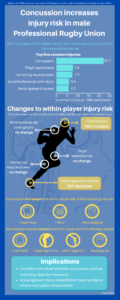Key words: concussion, hamstring, ankle, shoulder, rugby
Rugby Union has one of the highest injury rates of any team sport, with concussion and lower limb injuries particularly common (1,2). Players also sustain multiple injuries during their career, which may impact their risk of future injuries (3). This blog summarises our recent original research into injury risk in male professional Rugby Union (4).
Why did we do this study?
Concussion has been shown to increase injury risk in Rugby Union (5,6), but is it the only injury to have this effect? Are changes in concussion return to rugby protocols needed or is the increased injury risk part of injury occurrence regardless of what injury was sustained?
We sought to assess two types of injury risk of common injuries in male Rugby Union:
- A player’s change in injury risk (comparing injury risk before and after a common injury)
- Differences in subsequent injury risk following a common injured compared to all other injuries
How did we carry out this study?
We monitored time-loss injuries of Welsh professional male Rugby Union players over seven seasons, from 2012/13 to 2018/19. A total of 2888 injuries were sustained by 382 players. The 5 injuries with the highest match injury incidence were: concussion, thigh haematomas, hamstring muscle strains, acromioclavicular joint injuries and lateral ankle sprains. These were named common injuries. We then modelled the risk of injury before sustaining a common injury after the risk of injury after it. This allowed us to quantify changes in a player’s injury risk. Subsequent injury risk was also modelled by comparing the risk of injury following one of the common injuries and the risk following all other injuries. This quantified the difference in between-player subsequent injury risk. The number of days between injuries were also calculated for time to next injury.
Key findings
Our key findings for concussion were:
- Concussion was the only injury to elevate a player’s injury risk. Risk increased by 26%
- Concussion increased the risk of suffering head/neck, pelvic and neurological injuries
- Concussion increased subsequent injury risk by 24%
- Concussion shortened the time to next injury
Our key findings for lateral ankle sprains were:
- It was the only injury to reduce a player’s injury risk. Risk decreased by 30%
- It decreased the risk of suffering head/neck, upper leg and knee, joint/ligament and neurological injuries
- No change in subsequent injury risk
- No change in time to next injury
Our key findings for thigh haematomas and hamstring muscle strains:
- No change in a player’s injury risk
- Subsequent injury risk increased by 18% and 14%, respectively
- No change in time to next injury
Acromioclavicular joint sprains had no effect on a player’s injury risk, subsequent injury risk or time to next injury.
Take-home messages
Concussion return-to-rugby protocols need to mitigate the risk of injury following its occurrence. Objective assessments are recommended to ensure players have fully recovered.
Potential changes to return-to-rugby protocols include:
1) increasing the minimum time requirements;
2) greater levels of physical preparation;
3) including proprioceptive training;
4) objective assessments and;
5) rugby-specific assessments relating to decision making and skill execution.
Ankle ligament rehabilitation may be able to inform concussion rehabilitation due to the association between its occurrence and a reduced risk of head/neck and neurological injuries.

Written by Isabel S. Moore (1) on behalf of all the co-authors.
(1) Cardiff School of Sport & Health Sciences, Cardiff Metropolitan University, Cardiff, UK
Conflicts of interest: ISM is an Associate Editor for the British Journal of Sports Medicine. ISM received a research grant from Welsh Rugby Union.
References
- Bitchell CL, Mathema P, Moore IS. Four-year match injury surveillance in male Welsh professional Rugby Union teams. Phys Ther Sport 2020;42:26-32. doi:10.1016/j.ptsp.2019.12.001
- Williams S, Trewartha G, Kemp S, et al. A Meta-Analysis of Injuries in Senior Men’s Professional Rugby Union. Sport Med 2013;43:1043-1055. doi:10.1007/s40279-013-0078-1
- Moore IS, Ranson C, Mathema P. Injury Risk in International Rugby Union: Three-year injury surveillance of the Welsh national team. Orthapedic J Sport Med 2015;3:1-9. doi:10.1177/2325967115596194
- Moore, IS, Bitchell CL, Vicary D, et al. Concussion increases within-player injury risk in male professional rugby union. Br J Sports Med. doi: 10.1136/bjsports-2021-105238
- Cross M, Kemp S, Smith A, et al. Professional Rugby Union players have a 60% greater risk of time loss injury after concussion: A 2-season prospective study of clinical outcomes. Br J Sports Med 2016;50:926-931. doi:10.1136/bjsports-444 2015-094982
- Rafferty J, Ranson C, Oatley G, et al. On average, a professional rugby union player is more likely than not to sustain a concussion after 25 matches. Br J Sports Med 2018;44:1-5. doi:10.1136/bjsports-2017-098417